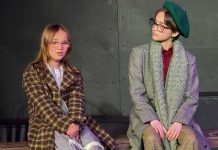John Cauthen, a Navy aviator from the Bay Area, provides another
glimpse into the early tsunami relief efforts in this e-mail sent
home just before midnight on Jan. 5. The Free Lance will continue
to publish Cauthen’s letters home throughout the week.
John Cauthen, a Navy aviator from the Bay Area, provides another glimpse into the early tsunami relief efforts in this e-mail sent home just before midnight on Jan. 5. The Free Lance will continue to publish Cauthen’s letters home throughout the week.
The Marines have arrived with some heavy lift helicopters and engineering battalions to begin rebuilding the infrastructure – first and foremost, the road down the coast. Once this is repaired, along with the dozen or so washed out bridges, the relief effort will become exponentially easier. More food, more water and more medical help will arrive. As of now the only way to reach the people is via helicopter and there are not nearly enough. More and more arrive daily but the level of need is staggering in proportion to what we can physically handle.
This, however, is not to underscore the good that we have been doing everywhere. As of today we have delivered well over 500,000 pounds of food, water and medical supplies. This is flying from day break to sunset during the last five days and the end is not in sight yet.
As a subset to our primary mission we, as a crew, have been deciding to save a few bags of rice and a few cases of water after we drop our main load off at the distribution points, set up at three different places up and down the coast. We have been searching for targets of opportunity when we see pockets of stragglers wandering the roads or congregating together in makeshift camps. For those that we cannot directly help, we will overfly and mark a position using GPS so that the information can be passed to the next crew. Our hope is that we will be able to relieve those that have been abandoned along desolate stretches of road and swamp land with nowhere to travel.
Today we left the ship at dawn and flew to Banda Ache to drop off our stalwart load crew. These men and women should be commended and handed congratulations as they remain under an unrelenting sun all day loading an unending line of aircraft. The physical stamina of these people is unbelievable when one stops to think that they are loading ton after ton of cargo from dawn until dusk. To compound their difficulties the malaria pills we are taking make our skin extremely sensitive to the sun. The young men and women who are sweating profusely, smile through scorched and sunburned faces and continue to heave food as if their very lives depend on it.
This, to me, is the unlimited goodwill inherent in the American character, and the images that I have been privy to are a testament to that very notion. No matter what the world says of us, I know that the citizens of this country are the most generous and gracious on the face of the planet.
As we landed and let out our sailors to commence their days work, we learned we would transport a contingency of Air Force special forces. They were to be taken to an airfield at Sabang, an island north of Banda Ache. Their mission was to survey the airfield, its runway and determine if it would be a suitable base to bring in heavy lift Air Force cargo planes. The main impetus for this was twofold: Sultan airfield at Banda Ache is becoming inundated with people, aircraft and cargo; and the previous night the first mishap occurred in which a landing 737 struck a water buffalo. The 737’s left main mount collapsed and the aircraft skidded to a halt halfway down the runway. This closed the airfield for nearly an entire day. Operations were stalled and refugees remained stranded. But the surplus of food remained and thankfully we were able to continue flying our missions.
When we finally arrived at the secondary airfield at Sabang, we found a community that had somehow miraculously survived the tsunami. The island itself is essentially a mountain in the ocean. The population centers were either spared the devastation because they are located on the high ground or they were shielded on the leeward side of the wave. As we flew over the town, life moved on as if nothing had happened but the view across the channel spoke of a different story.
How strange the way a disaster will strike, sparring some and completely devastating others. Our target airfield was located atop a mountain. It is as if someone just took a knife to the top of a mountain and lifted it right off and then engineers built an airfield and runway. As you fly in the approach end of the one runway, there is a slight grade and then the base. We sat on deck for a few minutes as we dropped off our human cargo and embarked another set. Aid workers were to accompany us back to Banda Ache and any skills that could be brought in were more than welcomed as everyone is short on help, especially those in the medical field. We departed to the opposite end of the runway and what amazed me is that as soon as you crossed the limit there was a sheer drop down a steep precipice to the edge of the water.
My peers and seniors continued through the day delivering much need supplies. We reluctantly turned our aircraft over to the next crew, bid them good luck and off they went to pick up where we left off.









